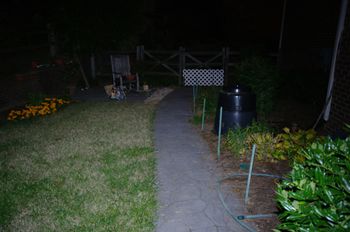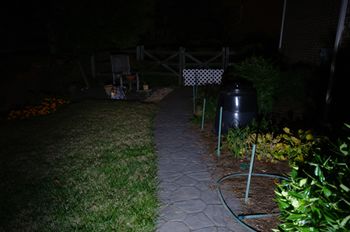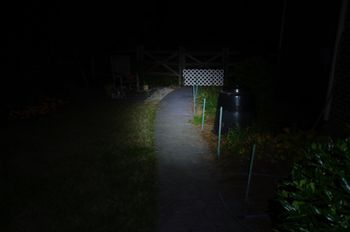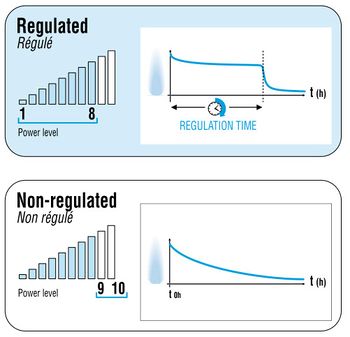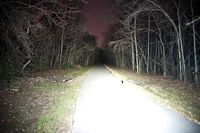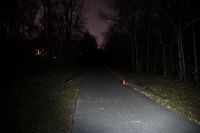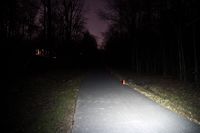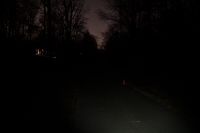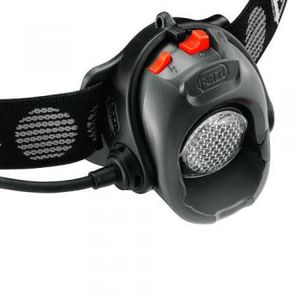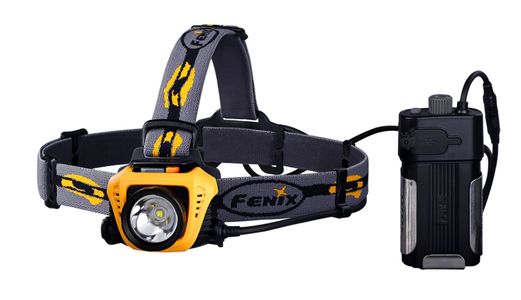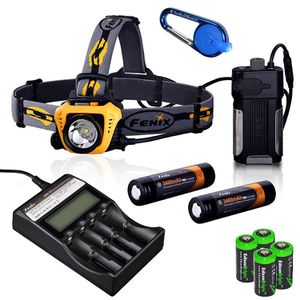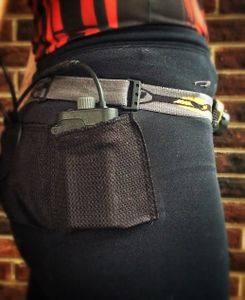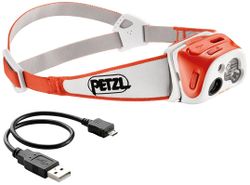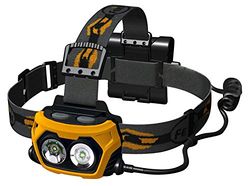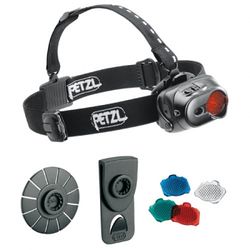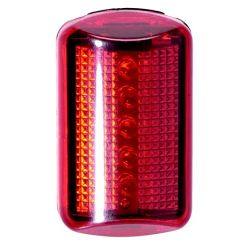Best Running Lights
There are many lights available for runners depending on your need, but some are far better than others. Below are the key factors to look for in a light and a comparison of the best running lights.
1 What to look for
There are four factors to consider with a running light; location, the beam pattern, regulation and brightness.
1.1 Location
The first step in choosing a light is to work out where you want the light; in your hand, at your waist, or on your head.
1.1.1 Head Mounted
Most people use head mounted lights, and they have a number of advantages:
- Head mounted directs the light where you point your head, making it easier to see where you're going.
- Head mounted also works better for directing the light to things in your hands, like putting on gloves or looking at your Running Watch.
- Head mounted lights are better at showing up branches or spider webs that are about to hit your face.
- Most of the lights are head mounted, so you have the widest choice.
1.1.2 Waist Mounted
Waist mounted lights are fairly unusual, but they're worth considering for several reasons.
- Waist mounted lights are much better at showing you the shape of the ground, and any obstacles are a lot more apparent. This is because a head mounted light aligned with your eyes so there's few shadows. . This is best seen in the images above.
- In rain or dusty conditions a waist mounted light will not create glare in front of your face. With a head mounted light, the beam picks up the rain or dust, and because of the closeness these particles are brightly lit. It can be hard to see through these spots, and the effect can be quite claustrophobic.
I sometimes run with BOTH head and waist mounted lights, which provides the best of both worlds. The waist mounted light gives me the shape of the ground, and a head mounted spot light helps me look around.
1.1.3 Handheld
I don't recommend handheld lights for several reasons. The biggest problem is that keeping the light pointed in the right direction changes your arm movement and this messes up your Running Form. In addition, handheld lights occupy one of your hands making it tricky to do anything in the dark, though knuckle lights overcome this.
1.2 Beam Pattern – Spot vs Diffuse
Many lights project a narrow spot beam that illuminates longer distance, which can be handy for navigation, especially on ill-defined trails. Most of the time I prefer a light with an evenly diffused beam, even though it does not reach as far as a spot beam.
1.3 Regulation – Light output over time
With a regulated light the light intensity will stay constant over most of the life of the battery. When the battery is nearly depleted, the light will rapidly dim (see the graph below.) The regulation is nice, but when the end of the regulation period is reached, the light intensity can drop so quickly that you get caught out.
1.4 Brightness
The brightness you need depends on your situation. In many cases you just need to see what's immediately ahead of you, so brightness is not critical. If you're on trails, then a really bright light can help see what direction a trail is taking, or help with navigation. A bright light can also help psychologically, as a small pool of light can become confining and claustrophobic. However, if there's a little more ambient light, then a dim light can work best. A dimmer light can provide enough to shoe you what's ahead without compromising your night vision. Having a light that will go both very bright and very dim is ideal, and several of the lights I recommend can provide both extremes. The images below are from the recommended lights on their brightest settings. For pictures of the other brightness settings and the details of the photographs, see Running Light Gallery.
| (No flood mode for e+Lite) |
2 Light Reviews
Each of these lights has its pros and cons.
- Petzl MYO RXP. This is my preferred light for general night running where I need more light than the Tactikka can provide. Error: Could not parse data from Amazon!.
- Fenix HP30. I only use the HP30 when I expect to need more light for navigation than the MYO RXP, or when I want the bright light to help me psychologically. Error: Could not parse data from Amazon!.
- Petzl Tikka RXP. I occasionally use this light when I want the reactive lighting. Error: Could not parse data from Amazon!.
- Fenix HP25. I rarely use this light, but it's worth considering if you want lots of light and don't want to pay for the HP30. Error: Could not parse data from Amazon!.
- Petzl Tactikka XP Adapt. This is the light I'm most likely to take for urban running due to its light weight and optional waist mounting. This would be one of my top recommendations, but sadly it's discontinued and there's no replacement model. (You can still find it if you hunt around.)
- Petzl e+lite. I have several of these that I can put into drop bags in ultras, or carry with me as an ultra-lightweight backup light. Error: Could not parse data from Amazon!.
| Light | Link | Weight | Weight on Head | High Brightness (absolute) | High Brightness (perceived) | Battery Life on High | Battery pack | Waist Mounted? | Waterproof | Rear Light | Regulated? |
|---|---|---|---|---|---|---|---|---|---|---|---|
| Black Diamond Sprinter | Error: Could not parse data from Amazon! | 3.8 | 3.8 | 180 | 5.5 | 6h | Rear | No | Splashproof (IPX4) | Yes | Yes |
| Foxelli MX500 | Error: Could not parse data from Amazon! | 4.7 | 4.7 | 250 | 6.2 | 8h | Rear | No | Yes, IP7 (waterproof 1 meter for 30 minutes) | No | No |
| GoMotion Orion | Not yet on Amazon | 6.0 | 0.0 | 30 | 3.1 | 8h | Waist Mounted | Yes | No (IPX3, semi-splashproof) | Yes | No |
| Fenix HP30 | Error: Could not parse data from Amazon! | 13.8 | 5.9 | 750 | 8.9 | 3h50 | Waist Mounted | Maybe | Mostly, (IPX6, low pressure jets of water) | No | Yes |
| Fenix HP25 | Error: Could not parse data from Amazon! | 9.9 | 9.9 | 500 | 7.8 | 7h30 | Rear | No | Mostly, (IPX6, low pressure jets of water) | No | Yes |
| Petzl e+Lite | Error: Could not parse data from Amazon! | 1.6 | 1.0 | 15 | 2.4 | 55h | N/A | No | Yes (IP67, waterproof 1 meter for 30 minutes) | No | No |
| Petzl Tikka RXP | Error: Could not parse data from Amazon! | 4.0 | 4.0 | 180 | 5.5 | 2h30 | Front | No | Splashproof (IPX4) | No | Yes |
| Petzl Tactikka XP Adapt | Discontinued | 3.1 | 4.0 | 8 | 2.0 | 2h30 | Front | Yes | Splashproof (IPX4) | No | No |
| Petzl MYO RXP | Error: Could not parse data from Amazon! | 5.8 | 5.8 | 180 | 5.5 | 1h20 | Rear | No | Splashproof (IPX4) | No | Yes |
| Coast HL6 | Error: Could not parse data from Amazon! | 4.4 | 4.4 | 90 | 4.4 | 1h30 | Rear | No | "Weather Resistant" | No | No |
| GRDE Zoomable | Error: Could not parse data from Amazon! | 9.7 | 9.7 | 350 | 6.9 | 4h | Rear | No | Maybe ("Living Waterproof" claimed) | No | No |
2.1 Petzl MYO RXP
I find that the Petzl MYO RXP is a nice compromise between brightness and weight.
- In regulated mode the light will flash a few times when the battery drops too low, which gives you some warning before it runs out of power.
- The RXP also provides an unregulated mode that is brighter than the brightest regulated beam. This unregulated mode is useful when you need a lot of light for a short period of time.
- The regulated output can be used so that you will have power for an overnight run, and on its lowest power setting it will run for 96 hours.
- The RXP can generate a very dim light which works well near dawn. I can balance the output from the RXP on so I have enough to see by, while allowing my eyes to adjust so that I can see a little further using the available light.
- The RXP is not waterproof, though it works well in heavy rain as long as it is in the normal position. If you run with it wrapped around your hand, the rain can get in the underside and cause problems until it dries out.
- The RXP uses three AA batteries, so it is a little heavy, but having the batteries on the back balances things quite well.
- The rear mounted batteries keep them warmer in cold conditions if you wear it with the back under a hat; you'll probably need two hats to make that work.
- The RXP has a diffuser that flips up and down, making it easy to swap between diffuse and spot beams while running.
The MYO RXP is Error: Could not parse data from Amazon!.
2.2 Fenix HP30
The HP30 is an amazingly bright light, but it's also amazingly heavy. While I love the intense bright light the HP30 produces, I tend not to use this light as much as the Petzl MYO RXP or Tactikka. This is a product with rather extremes of benefits and downsides, but if you need a really bright light, this is a great option.
- The battery pack is waist mounted, but even then it's heavy enough to be awkward. Having the battery pack clipped into a waist belt tends to chafe, but if you remove the metal holder the plastic battery pack will fit into the pockets of the Race Ready Shorts and Tights (see picture below).
- The HP30 can be used strapped around your waist, though this may not work if you have a larger waist. You can use other headlights around your waist, but those with the batteries and light in a single unit tend to be heavier and bounce too much.
- The separate battery pack is handy in extreme cold, as you can keep the batteries warmer (a cold battery does not generate as much power.)
- One a nice feature of the HP30 is that you can charge USB devices from the battery pack.
- The HP30 produces a bright light for a long time, but to do so it requires expensive and specialist batteries. Unlike most of the lights listed here, the HP30 requires two rechargeable 18650 batteries which are about $10 each and require a specialist charger. Because of their cost, there seems to be a problem with poor quality fakes, so be careful when purchasing. The HP30 will also work with non-rechargeable CR123A batteries, but these work out even more expensive in the long run.
- Like the Petzl MYO RXP, the HP30 has a flip up diffuser that can be easily operated while running. Unlike the Petzl, the diffuser is rather flimsy. In fact, overall the Fenix lights do not feel as high quality as the Petzl lights. They work well, and I've not had any issues with the Fenix lights even after extensive use and abuse, but I still prefer the Petzl.
You can get the light on its own as Error: Could not parse data from Amazon! or as the Error: Could not parse data from Amazon! which includes batteries and charger.
2.3 Petzl Tikka RXP
The Petzl Tikka RXP is a sophisticated light that automatically adjusts the brightness depending on the conditions. When the sensor sees little light, the brightness of the LEDs is increased. So if you point your light into the distance, the brightness will increase, and if you point at something nearby, the brightness is reduced. This can work quite nicely when running, as it can be configured to use the dimmer wide beam when you're looking near your feet, and the longer throw spot beam when you look up to see further ahead. If you look at your watch (or anything else close up) the light will dim so you're not blinded. I've found that the dynamic brightness is sometimes nice and sometimes annoying, but overall it works well and can provide a bright light on full power.
- The Tikka RXP also has a constant mode that is regulated, and both modes have three levels of brightness.
- You can also program the light using a computer (PC or Mac) to change the configuration.
- However, the close up mode is also activated if a light is shining at you, making it a poor choice for running near oncoming cars. I've also found the light will go dim if you're near reflective signs that bounce more of the light back. It can be quite disconcerting to be plunged into darkness as you approach a street sign.
- There are two LED bulbs, one with a diffuse wide beam and the other with a narrow focused beam, along with a light sensor.
- The Tikka RXP comes with a rechargeable battery for Error: Could not parse data from Amazon!, but can buy a converter to take 3 AAA batteries, or you can buy spare rechargeable batteries (Error: Could not parse data from Amazon!).
- The battery life varies on usage, so if you're doing a longer run, you'd want to carry spare batteries.
Petzl also make a more expensive version, the Nao for Error: Could not parse data from Amazon!, but I don't think it's worth the extra. There's also the cheaper Tikka R+ for Error: Could not parse data from Amazon!, but you don't save enough to make that worthwhile.
2.4 Fenix HP25
While I love the brightness of the HP25, I find it's too heavy for extended use. If I need this level of brightness, I prefer to take the HP30 which has a waist mounted battery pack. However, because the HP30 is so much more expensive, the HP25 may be a more viable option for those wanting a bright light on a reasonable budget. The HP25 is Error: Could not parse data from Amazon!.
- The HP25 weighs 70% more than the Petzl MYO RXP, and like the Petzl it balances its weight between the front and the back of your head.
- The rear mounted battery pack allows you to keep the batteries warmer, which improves their power output and lifespan in cold conditions.
- The HP25 has separate LED bulbs for spot and diffuse beams. This allows you to tweak the beam pattern to suit your need. You can have a bright diffuse beam with a dimmer spot, or vice versa.
- The Fenix lights are a little more splash proof than the Petzl lights, but neither are waterproof.
2.5 Petzl Tactikka XP Adapt
The Petzl Tactikka XP Adapt is unusual in that it can be waist mounted, which makes it one of my favorite lights. Sadly, Petzl has discontinued this light, though it can still be found occasionally. There is no replacement light that includes the ability to be waist mounted, so it's worth tracking down. The waist mounting works best with compression shorts/tights to prevent the light wobbling around. The XP Adapt uses three AAA batteries, so it's lighter than the Petzl MYO RXP. The Tactikka XP is quite a bit cheaper than the MYO RXP, but nowhere near as bright, and it's quite dim compared with the Fenix lights. I find I have to have this of light on the full power, so the battery life is only 2 hours, and it's not regulated, so it gets dimmer as the battery runs out. Like in the MYO RXP, the Tactikka XP has a diffuser that moves in front of the beam, but instead of flipping up and down, the Tactikka XP's diffuser slides to the side. This is a fiddly affair and it's impractical to move the diffuser while running.
2.6 Petzl e+Lite
The Petzl e+Lite worth considering as a backup light, but don't use this as your primary light unless weight is of paramount importance. It's not quite bright enough for general use and the lithium batteries are pricy. However, it will fit in the pocket of my Race Ready Shorts, so it makes a great 'oops' light. The e+Lite is Error: Could not parse data from Amazon!.
This is a gallery of real world performance of these lights. A photo was taken for each setting on each light to display the differences.
3 Other Thoughts
3.1 Safety lights
A flashing red light clipped to the back of your waist band is a worthwhile addition for running in urban situations. The Nathan Clip-On Safety Strobe is less than $10.
3.2 Batteries
I use Enloop Low Self Discharge rechargeable batteries in my lights. The 'low self discharge' means that they won't go flat if you leave them in a drawer for a few weeks. I got the La Crosse Technology BC-700 Alpha Power Battery Charger which is more expensive than many at $50, but well worth it for keeping the batteries healthy.

